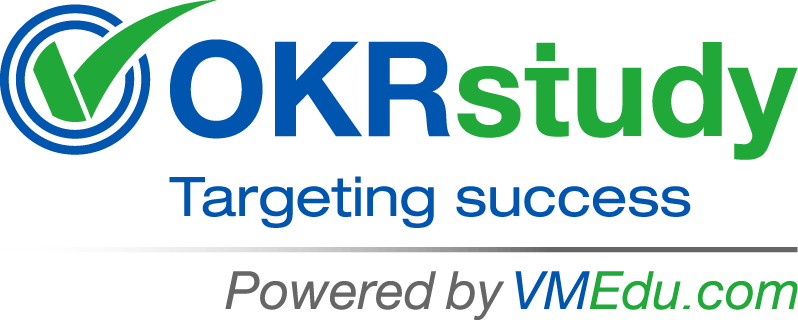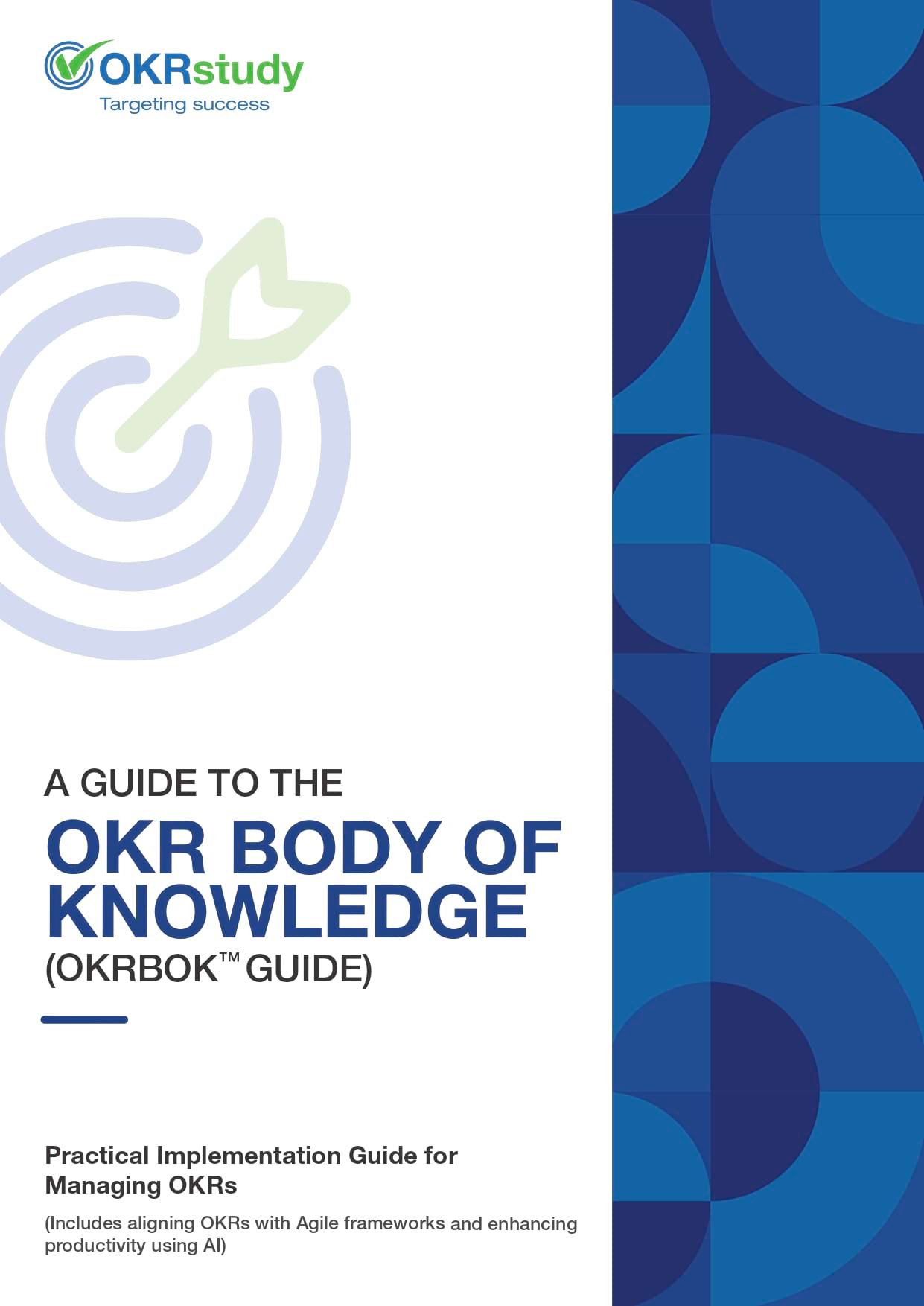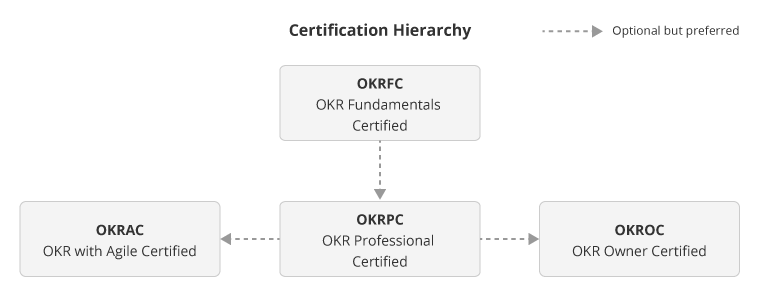Objectives and Key Results (OKR):
OKR Professional with AI Certified (OKRPC)
6 months e-learning + web-based exam
€200 + VAT
“Clear objectives guide direction; measurable results ensure progress.”
“When goals are visible and measurable, focus becomes a shared commitment.”
“Every key result is a milestone that brings your organization closer to its vision.”
Objectives and Key Results (OKRs):
OKR Professional with AI Certified (OKRPC)
E-learning + Web-based examination
This course and exam are for anyone looking to understand OKRs and enhance goal alignment and performance tracking.
Key information about this course:
Price: €200 + VAT ( 6 month E-learning + exam voucher)
- Instructor led video presentations
- Printable online student courseware
- Online testing with detailed responses

The OKR Professional with AI Certified (OKRPC) course is designed for professionals seeking in-depth knowledge of OKR principles, roles, artifacts, and processes. This certification equips individuals with practical skills to implement and manage OKRs effectively, ensuring strategic alignment, enhanced collaboration, and measurable performance tracking across teams and organizations.
Benefits of OKRs
OKRs are a versatile goal-setting framework that improves alignment, focus, and adaptability across industries. They enhance transparency and accountability by defining clear objectives and measurable key results, allowing teams to track progress in real time and optimize performance. By prioritizing key initiatives, enabling faster decision-making, and ensuring alignment with strategic goals, OKRs boost productivity. AI integration automates tracking and analysis, further improving efficiency. Their flexibility supports various industries and remote teams while fostering continuous improvement through data-driven insights and regular check-ins. By driving goal clarity, reducing ambiguity, and ensuring measurable outcomes, OKRs help organizations enhance performance and maintain operational excellence.
Origin
OKRs (Objectives and Key Results) originated at Intel in the 1970s under CEO Andy Grove, who championed clear, measurable goals to align employees and drive performance. Based on Peter Drucker’s Management by Objectives (MBO), OKRs introduced a more structured and agile approach. Initially used for individual performance tracking, OKRs quickly scaled company-wide to enhance focus and alignment. Former Intel executive John Doerr later introduced OKRs to Google, leading to widespread adoption.
Today, organizations across industries, including startups and non-profits, use OKRs to track progress, maintain alignment, and drive continuous improvement, making them a vital tool for sustained success.
Overview of OKRs
OKR Application Areas
OKRs (Objectives and Key Results) are a goal-setting framework that can be applied in various areas to drive alignment, performance, and results. Some common application areas for OKRs include:
| Application Area | Key OKR Applications |
|---|---|
| Corporate Strategy and Leadership |
|
| Product Management |
|
| Marketing |
|
| Sales |
|
| Human Resources |
|
| Engineering and Technology |
|
| Customer Service |
|
| Finance |
|
| Non-Profit Organizations |
|
OKR Principles
The principles behind OKRs (Objectives and Key Results) are designed to help organizations set clear, measurable, and ambitious goals while ensuring alignment and focus. OKR principles are:
- Focus on What Matters Most – OKRs emphasize setting a small number of high-priority objectives (usually 3-5 per quarter).
- Ambition with Achievability – OKRs encourage setting stretch goals that push the organization to aim higher.
- Measurable Key Results – Key Results are specific, quantifiable, and time-bound. They define what success looks like and allow progress to be objectively tracked.
- Alignment and Transparency – OKRs should be set at various levels (company, team, individual) and be aligned across the organization.
- Regular Check-ins and Updates – OKRs are typically reviewed regularly (e.g., weekly, bi-weekly, or monthly).
- Commitment to Results – OKRs are focused on outcomes rather than activities. The emphasis is on achieving meaningful results, not just completing tasks.
- Transparency, Ownership, and Accountability – Everyone in the organization should have visibility into the OKRs set at all levels.
- Stretch Goals and Learning from Failure – OKRs should be ambitious enough to stretch the organization, but not every objective needs to be fully achieved.
- Short-Term Focus – OKRs are generally set on a quarterly or annual basis.
- Inspiration and Motivation – While OKRs are focused on measurable results, they should also inspire and engage employees.
OKR Artifacts and Reports
OKR artifacts are documents and tools used to set, track, and evaluate OKRs, ensuring clarity, alignment, and transparency across teams. Common artifacts include the OKR framework template, alignment strategies, implementation tools for OKR, OKR templates, OKR dashboards, and OKR review meetings for continuous assessment and progress tracking.
OKR Processes
OKR processes are iterative and adaptive, involving implementation, tracking, and improvement. They are not strictly sequential but overlap. For ease of understanding, OKR processes are grouped under three phases as shown below:
| Phase | OKR Processes |
|---|---|
1. Set-up OKR Implementation PhaseThe Set-Up Phase in OKRs includes processes related to understanding organizational goals and defining OKRs at various levels. |
1. Understand Strategic Vision and Priorities:
2. Finalize OKRs:
|
2. Execute PhaseThe Execute Phase involves tracking and adjusting OKRs to ensure teams remain aligned and adaptable. |
1. Track and Adjust OKRs:
|
3. Review and Improve PhaseThe Review and Improve Phase involves evaluating OKRs and conducting retrospectives for continuous improvement. |
1. Conduct OKR Reviews and Retrospectives
|


